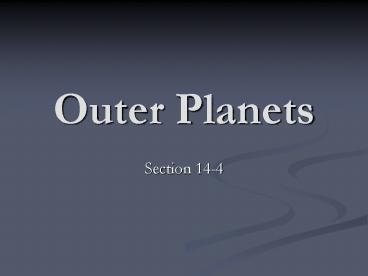Outer Planets - PowerPoint PPT Presentation
1 / 12
Title:
Outer Planets
Description:
Outer Planets Section 14-4 Outer Planets The gas giants-Jupiter, Saturn, Uranus, and Neptune Much larger than Earth and do not have solid surfaces Atmospheres are all ... – PowerPoint PPT presentation
Number of Views:228
Avg rating:3.0/5.0
Title: Outer Planets
1
Outer Planets
- Section 14-4
2
Outer Planets
- The gas giants-Jupiter, Saturn, Uranus, and
Neptune - Much larger than Earth and do not have solid
surfaces - Atmospheres are all very similar to each other
- Mostly hydrogen and helium gas
3
Jupiter (Roman Supreme God)
- Very thick atmosphere-mostly hydrogen and helium
- Great Red Spot - ongoing storm that is at least
twice the size of Earth. - The largest of all the planets
- Has 67 moons
4
The Great Red Spot
5
Jupiters MoonsThe 4 Galilean Moons
6
The Great Red Spot
7
Saturn (Roman God of Agriculture)
- Second largest planet
- Has 63 moons
- Rings of ice and rock orbit the planet and can be
seen from earth without special optics
8
Saturns Moons
9
Saturns Rings
High resolution photographs from the Voyager
missions indicate that the rings of Saturn are
composed of hundreds of thousands of "ringlets",
and that regions like the largest "gap" called
the Cassini division, also contain fainter rings.
They may possibly be either a moon torn apart by
tidal forces, or material that was never allowed
to turn into moons because of the tidal forces.
10
Uranus (Romans Earliest Supreme God
Grandfather of Jupiter)
- Rotates from top to bottom-tilted 90?
- Looks bluish because of methane in atmosphere
- Has 27 moons
11
Uranuss Moons
Voyager 2 obtained clear, high-resolution images
of each of the five large moons of Uranus known
at the time Miranda, Ariel, Umbriel, Titania,
and Oberon . The two largest, Titania and Oberon,
are about 1,600 kilometres (1,000 miles) in
diameter, roughly half the size of Earth's Moon.
12
Neptune (Roman God of the Sea)
- Atmosphere similar to other gas giants and has
visible clouds - Had a Great Dark Spot - storm the size of earth
that is now gone - Has 13 moons
13
Neptunes Moons
14
The Great Dark Spot
Recent observations of Neptune using the Hubble
Space Telescope suggest that the Dark Spot seen
by Voyager 2 has gone away yet has apparently
been replaced by another dark spot.
15
Pluto (Roman God of the Underworld)
- Is now a dwarf planet
- Has a solid surface
- Size is less than 2/3 Earths moon
16
Pluto
17
Plutos Moons































